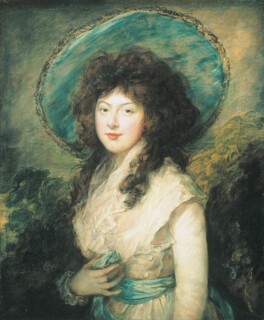The ability to achieve a likeness was always to some degree an innate talent. At the highest level it was the rarest representational skill and – in England at least – the most marketable. It was a gift which Thomas Gainsborough showed early; in one account, so impressing a friend of his mother’s when he was still a boy that his father was persuaded he should go to London for instruction. But this talent wasn’t necessarily combined with other painterly abilities. Gainsborough and Maurice-Quentin de La Tour were both reckoned remarkable getters of likeness, and both had significant weaknesses, or lack of interest, in other departments. Contemporaries claim again and again that their portraits seem to put you in the presence of a person, not a picture. It was probably Gainsborough’s friend Philip Thicknesse who wrote that his ‘pictures may not be said so properly to be like the originals as to be the people themselves’, and similar remarks were made about La Tour’s pastels. The critical language would be equally appropriate for a piece of legerdemain – which was, in a way, what the use of flickering marks on a surface to conjure up a person amounted to.
Likeness, and the way Gainsborough achieved it, was an issue in his own time. The notion that the imagination is stimulated to activity when starved of specific information was advanced, and the way that this manipulation of our powers of perception is carried out was described. His obituarist in the Gentleman’s Magazine said that ‘the picture may almost be mistaken for the original: but closely inspected we find scumbling scratches that have no appearance of eyebrows or nostrils.’ It is worth making a circuit of the Tate exhibition (which ends on 19 January) looking at the portraits close to for such details – all the time keeping in mind things Rica Jones and Martin Postle explain in their catalogue essay, ‘Gainsborough in His Painting Room’.* For example, that he said he could not ‘without taking away the likeness’ touch a portrait ‘unless from the life’; the report from Ozias Humphry, who watched him at work in Bath in the early 1760s, that he had canvas and sitter placed side by side, even adjusting the position of the canvas on the stretcher (it was, at this point, tied not tacked) to bring image and face closer together, and that he began painting in a shaded room where most natural light was replaced by candlelight; that (this from his daughter) ‘his colours were very liquid and if he did not hold the palette right would run over.’ A description of him working in London speaks of brushes mounted on six-foot sticks – which put him at the same distance from subject and canvas, set at right angles to each other. Reynolds commented that the way the resulting ‘odd scratches and marks’ came together at a distance to give form was, for the painter, a matter of pride: Gainsborough wanted people to look close up and take pleasure in the dance of marks as well as to admire the distant view. ‘’Tis actual motion, and done with such light airy facility. Oh! it delighted me when I saw it,’ James Northcote, a pupil of Reynolds, said, having watched Gainsborough at work on Queen Charlotte’s drapery.
But these accounts of his later practice are irrelevant to the pictures one turns to first: those crisp, bright, freshly coloured group portraits in landscapes, of which Mr and Mrs Andrews is now the most famous, painted when he was in Sudbury and, later, in Ipswich. In these the trees and fields are as fully characterised as the people, the brush strokes neat, not feathery, and the likenesses, I suspect, decent rather than magical. But even among this group, there are pictures in which stage scenery seems to have taken the place of English countryside, adumbrating the fluent, perfunctory elegance of the rocks and trees among which later sitters pose (and which, in debased form, had a long history as photographers’ studio backdrops). The Self-Portrait done just before his move to Bath – a significant step up the social ladder – makes the subjects of earlier pictures (the Gravenor family of Ipswich, for example) look the provincials they were.† The change of mood, a new suavity and elegance, is reflected in – even the product of – a technical move from neat strokes which follow contours to fine hatchings which cross them. It seems that Gainsborough had this trick from French pastel painters, like La Tour, by way of Allan Ramsay.
Follow the changes in the way faces are represented from picture to picture, and the formulae become clearer. Outlines of cheek, chin and nose are soft and blurred. Eyelashes and lips are shown in sharply pencilled strokes. In the pictures of girls – Miss Catherine Tatton (1786) is an extreme example – black and carmine are applied so crisply that you would, today, think of mascara and lipstick. This way of drawing detail with a small, sharp brush on the softly modelled face brings attention to just those features in which minute changes are registered as moods: the corners of the mouth where novelists have smiles hover, the firm line of the lips that signals decision, the highlights that make eyes twinkle, the drooping lids beneath which they smoulder. Their flickering, calligraphic imprecision lets expressions seem to come and go, and by these expressions the ‘presence’ which was so admired comes to have a character. Although, in their moderation, they are the antithesis of the models offered by 17th-century academic manuals, which show how expressions appropriate to grief, joy, envy or what have you are configured, Gainsborough’s near-smiles are also, in their own way, conventional. The expression Mrs Siddons wears is untheatrical, as she might appear in a drawing-room, while Reynolds’s Mrs Siddons as the Tragic Muse puts her on the stage in a more imperious mood, but both are struck poses. Mrs Sheridan is sitting in a wild romantic landscape, but her expression is politely arranged – you can imagine her looking at herself this way in her own mirror. In these portraits one surely has, if not people as you might wish to see them (as Goya, who admired Gainsborough and whose technique is not dissimilar, might have painted them), then people as they wished to see themselves. In the editors’ catalogue essay on ‘sensibility’, Gainsborough’s ability to suggest amiable sympathy is put in a literary context: from the tougher philosophy of Adam Smith’s Theory of the Moral Sentiments, through gentler attempts to link the distress the sight of poverty causes with benign attitudes to the poor, to comedies like The Man of Feeling which mock ineffectual good intentions. Henry, Third Duke of Buccleuch, painted with his dog (both charmingly unaggressive; both, the sharp highlights suggest, damp-eyed), seems to listen to you quietly, keen to agree, to conciliate, perhaps even to persuade you to improve your ways.
The portraits attended to, one turns to the ‘fancy pictures’ (country scenes, pictures of poor children) and landscapes: not dismissively, like the London sitters who passed the landscapes ‘ranged in long lines from his hall to his painting room’ without deigning ‘to honour them with a look’, but almost guiltily, conscious of having been distracted by that fashionable crowd. When the economical style of the portrait backgrounds is applied to cottages at dusk, cattle drinking or Claudean crags and groves the dash cannot make up for the fact that these are pictures of pictures. So, too, are the early Dutch-influenced landscapes, but there the models were not reconstituted in his imagination but used to enhance direct observation.
His fluency and ability to get a likeness produced portraits of inimitable ease in which things that move or flutter – faces, shawls, skirts, hair – are wonderfully realised. One forgives him the odd paper-doll body and stage-painter tree. In the end his fate was one that portrait painters are prone to: to find that the job becomes wearisome, but that things done with more pleasure from imagination lack the edge the business of getting a likeness gives. Many of his happiest successes are pictures of his daughters, his wife and friends. There the tricks of the trade are less in evidence, his ability to do well by faces generously rewarded.
Send Letters To:
The Editor
London Review of Books,
28 Little Russell Street
London, WC1A 2HN
letters@lrb.co.uk
Please include name, address, and a telephone number.


